20 Questions with Environmental Designer Troy Bankord |
You've probably seen his handiwork on a drive through Beadle's Paradise Gardens or Haver's Starlite Vista -- if not in the pages of Desert Living, Atomic Ranch and Phoenix Home and Garden. The homes he has owned, remodeled and sold have certainly turned many a head with his signature style of curb appeal.
Daniel Germani and Alison King set out to discover the method and man behind it all, designer Troy Bankord. Troy indulged them with answers to twenty questions that offer a good glimpse behind his design process and aesthetic ambitions. |
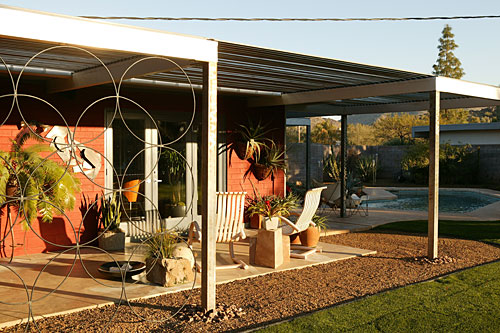
Photos by Jeffrey Green |
 We hear the term landscape architect thrown around all the time, but let us not make any assumptions. What exactly is it that a good contemporary landscape architect does? We hear the term landscape architect thrown around all the time, but let us not make any assumptions. What exactly is it that a good contemporary landscape architect does?
|
 My definition of a landscape architect is a professionally trained individual who has the capabilities to conjoin a residence and its exterior (landscape) surroundings, with the addition of architectural elements to the site. The overall affect is to achieve project continuity -- such as extending the wall of the home into the landscaping and designing an opening for an outdoor fireplace or taking a roof angle and flip-flopping it onto the ground as planting bed edge or raised planter. A good contemporary landscape architect will know when less is more and enough is enough. Angles, spheres, cubes... Height variation. Architectural plantings. My definition of a landscape architect is a professionally trained individual who has the capabilities to conjoin a residence and its exterior (landscape) surroundings, with the addition of architectural elements to the site. The overall affect is to achieve project continuity -- such as extending the wall of the home into the landscaping and designing an opening for an outdoor fireplace or taking a roof angle and flip-flopping it onto the ground as planting bed edge or raised planter. A good contemporary landscape architect will know when less is more and enough is enough. Angles, spheres, cubes... Height variation. Architectural plantings.
I am not a landscape architect....I am an environmental designer. The only difference is that I don't need a license. My design sense is innate and I design coexisting interior and exterior spaces.
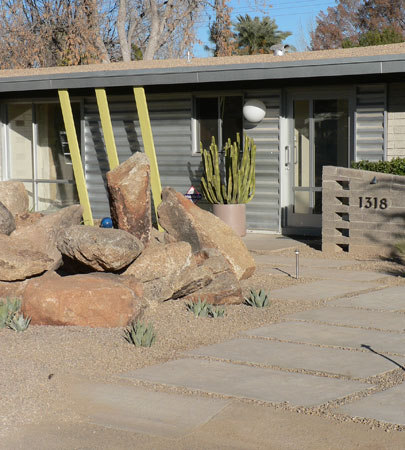
|
 What do you think is the most rewarding aspect of your vocation? What do you think is the most rewarding aspect of your vocation?
|
 Being there hands-on and appreciating the before and after states, both on-site and in publications. Also taking a property back to its glory and turning the neighborhood upside down in doing so. The biggest reward came when a client stepped from inside to the outside, stopped, turned around, walked through the glass doors again and commented about the flow from inside to outside. I wanted to kiss her feet! Being there hands-on and appreciating the before and after states, both on-site and in publications. Also taking a property back to its glory and turning the neighborhood upside down in doing so. The biggest reward came when a client stepped from inside to the outside, stopped, turned around, walked through the glass doors again and commented about the flow from inside to outside. I wanted to kiss her feet!
I like turning know-nothing outdoor spaces into destinations that my clients can now use makes me happy -- quiet gardens, fountain or sculpture gardens, play areas, ramada-covered patios, cutting gardens. I hate walls with concrete or grass bumped up to them.
I enjoy the letters and phone calls, too. |
 In which ways have the legacies of the Modern Architecture movement changed the traditional views on landscaping? In which ways have the legacies of the Modern Architecture movement changed the traditional views on landscaping?
|
 We now see plantings being massed and placed in strategic patterns. Travel to Palm Springs and you'll see green stone, white gravel and lava rock being used very effectively. I enjoy installing gravel roofs on my homes to tie them into the site. Even topiary and formal elements can be incorporated into modernist gardens if a clean, minimal look is utilized. Feng shui is basically about the flow of energy and balance. It's about what feels right and Feng shui is based on the minimal principals of Asia. Usually when people think about a garden they think green, flowers and shrubbery. We now see plantings being massed and placed in strategic patterns. Travel to Palm Springs and you'll see green stone, white gravel and lava rock being used very effectively. I enjoy installing gravel roofs on my homes to tie them into the site. Even topiary and formal elements can be incorporated into modernist gardens if a clean, minimal look is utilized. Feng shui is basically about the flow of energy and balance. It's about what feels right and Feng shui is based on the minimal principals of Asia. Usually when people think about a garden they think green, flowers and shrubbery.
|
|
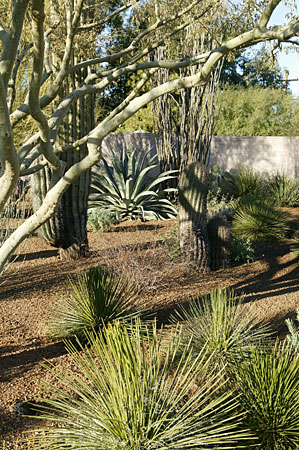
|
 Some of your projects do not follow these preconceived notions. How difficult is for you to sell a "conceptual garden"? Some of your projects do not follow these preconceived notions. How difficult is for you to sell a "conceptual garden"?
|
 My clients have seen my work in magazines, television or on garden tours. They also may live next door to a current client. Based on our meetings and the variety of gardens I have shown them, they know they will receive a very special garden that is geared to their needs and desires; one that no one else will have. Most of my clients end up going over budget, adding more bells and whistles once the concept begins to become a reality. They know I am only going to design what is appropriate; Form and Function. My clients have seen my work in magazines, television or on garden tours. They also may live next door to a current client. Based on our meetings and the variety of gardens I have shown them, they know they will receive a very special garden that is geared to their needs and desires; one that no one else will have. Most of my clients end up going over budget, adding more bells and whistles once the concept begins to become a reality. They know I am only going to design what is appropriate; Form and Function.
|
|  Does contemporary garden design live only in festivals and magazines or do you sense that some of the aesthetic is actually making it's way into everyday people's back yards? Does contemporary garden design live only in festivals and magazines or do you sense that some of the aesthetic is actually making it's way into everyday people's back yards?
|
 Contemporary gardens are here to stay!!! Whether it's with a portable fountain, patio furniture or streamlined pots. Contemporary gardens are here to stay!!! Whether it's with a portable fountain, patio furniture or streamlined pots.
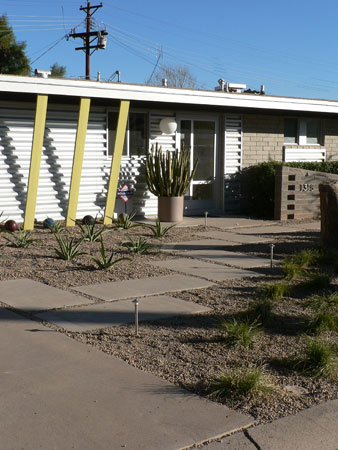
|
|  Do you think that the role of the outdoor designer is often underestimated? Do you think that the role of the outdoor designer is often underestimated?
|
 I definitely think the role of the landscape architect or environmental designer is underestimated. It kills me to see people spend money on new countertops, painting and flooring right before they sell their homes only to have a dumpster arrive following the closing. People want to personalize their own interiors in most cases. But pull up to a home with a great garden and street appeal and the house is often sold very quickly. Money magazine did a study years ago and found that kitchen and bath remodels had @ a 40-60% return on the dollar. Gardens had as much as a 200% return, since they were more comforting for the soul and helped the homes sell faster. I definitely think the role of the landscape architect or environmental designer is underestimated. It kills me to see people spend money on new countertops, painting and flooring right before they sell their homes only to have a dumpster arrive following the closing. People want to personalize their own interiors in most cases. But pull up to a home with a great garden and street appeal and the house is often sold very quickly. Money magazine did a study years ago and found that kitchen and bath remodels had @ a 40-60% return on the dollar. Gardens had as much as a 200% return, since they were more comforting for the soul and helped the homes sell faster.
|
|  What are the most common mistakes that new homeowners make when moving into a newly acquired property? What are the most common mistakes that new homeowners make when moving into a newly acquired property?
|
 People run to the nursery or the local discount home store chain and grab any old plants and stick them in the ground with no rhyme or reason. The watering system is usually not addressed. People are usually impatient and don't realized they will ultimately spend more shooting from the hip than hiring a professional and working off a plan. Cheapest isn't best and people usually get what they pay for. I grew up in a family of designers and contractors. The gardens were always installed first before any major interior work, so they could mature and be enjoyed. People run to the nursery or the local discount home store chain and grab any old plants and stick them in the ground with no rhyme or reason. The watering system is usually not addressed. People are usually impatient and don't realized they will ultimately spend more shooting from the hip than hiring a professional and working off a plan. Cheapest isn't best and people usually get what they pay for. I grew up in a family of designers and contractors. The gardens were always installed first before any major interior work, so they could mature and be enjoyed.
|
|
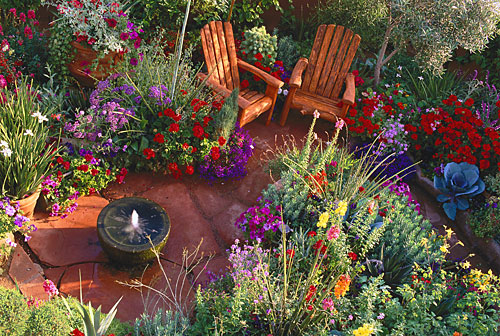
|
 What is the contemporary designer's responsibility, if any, to preserving the Recent Past on both an individual home and neighborhood scale? What is the contemporary designer's responsibility, if any, to preserving the Recent Past on both an individual home and neighborhood scale?
|
 This is a loaded question! As a designer stepping into a new neighborhood, I have choices in front of me and of course I am going to take a project to the next level. It is difficult, though, to do so if the client is not open to my ideas or is not sophisticated enough. These are usually projects I walk away from, as it is too frustrating otherwise. Clients will continue to throw money at a project trying to make it something it's not. In reality they hate their home/garden and should contemplate finding another home that fits their style and needs. It is my first and foremost desire to be true to the neighborhood. This is a loaded question! As a designer stepping into a new neighborhood, I have choices in front of me and of course I am going to take a project to the next level. It is difficult, though, to do so if the client is not open to my ideas or is not sophisticated enough. These are usually projects I walk away from, as it is too frustrating otherwise. Clients will continue to throw money at a project trying to make it something it's not. In reality they hate their home/garden and should contemplate finding another home that fits their style and needs. It is my first and foremost desire to be true to the neighborhood.
It saddens me to see the McMansions springing up all over the Valley. Low profile homes with character that hugged the desert floor and maximized mountain and city views are being leveled for the sake of the almighty dollar. Those homeowners who appreciate their low-lying homes often feel diminished and closed-in among their own neighbors. |
 What are some of the biggest challenges of working on a mid century modern project? Is it harder to design for a client or on speculation? What are some of the biggest challenges of working on a mid century modern project? Is it harder to design for a client or on speculation?
|
 I am a purist and it's all about the details with me. Crisp lines, clean corners, everything level -- Perfect angles and spheres. Those who appreciate modernist principles appreciate art objects and the perfection of the object's design elements. Getting your hands around a project budget is tricky if you are more detailed than your clients. Clients give me direction. I certainly have more freedom on my own projects, but I find it harder to make decisions on my own projects as I can see too many different options in my head. I am a purist and it's all about the details with me. Crisp lines, clean corners, everything level -- Perfect angles and spheres. Those who appreciate modernist principles appreciate art objects and the perfection of the object's design elements. Getting your hands around a project budget is tricky if you are more detailed than your clients. Clients give me direction. I certainly have more freedom on my own projects, but I find it harder to make decisions on my own projects as I can see too many different options in my head.
|
|
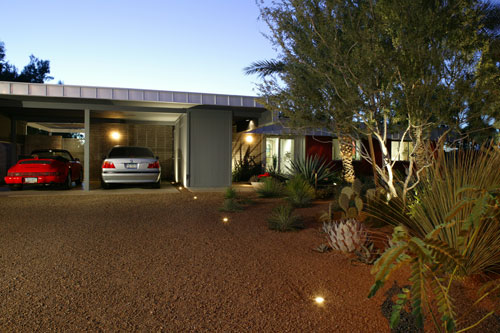
|
 What are your criteria when choosing a place to remodel? Do you dialogue with neighbors about changes to come? What are your criteria when choosing a place to remodel? Do you dialogue with neighbors about changes to come?
|
 I never dialogue with neighbors until I'm into a place. Original owners may fret about any kind of change, good or bad. In every case, my projects have created a ripple effect, whether in a modernist vein or not. I look for a home designed by a notable architect, possessing character or architectural detail in a nice, established neighborhood. Mountain or city views always pay off. In general, I look for good bones only; the rest I can embellish and create. I never dialogue with neighbors until I'm into a place. Original owners may fret about any kind of change, good or bad. In every case, my projects have created a ripple effect, whether in a modernist vein or not. I look for a home designed by a notable architect, possessing character or architectural detail in a nice, established neighborhood. Mountain or city views always pay off. In general, I look for good bones only; the rest I can embellish and create.
|
 Do you think that appreciation for mid-century modern is here to stay, or that it's just a fad? Do you think that appreciation for mid-century modern is here to stay, or that it's just a fad?
|
 It is here to stay. Look at our automobiles, electronics, even how we do our banking. We want clean simplicity in our hectic lives. I truly feel that the days of fussy homes and gardens are few and far between. Not that I don't enjoy doing a formal French garden every now and then! It is here to stay. Look at our automobiles, electronics, even how we do our banking. We want clean simplicity in our hectic lives. I truly feel that the days of fussy homes and gardens are few and far between. Not that I don't enjoy doing a formal French garden every now and then!
|
 What do you think accounts for all MCM's popularity in the media and among the creative class? What do you think accounts for all MCM's popularity in the media and among the creative class?
|
 It has been said that the craze started in Palm Springs with the relocation of gay men from L.A. and other climates. Because of the motion picture industry, the beauty of the mountains and palm trees, its proximity to L.A. for movies and photoshoots, the level of sophistication among it's residents and it's star-studded history with the Rat Pack and all, Palm Springs became the model for mid-century modern renovation, if you will. Palm Springs had its heyday in the 60's when most of the area was really developed. Celebrities wanted cool, clean, hip homes in which to party in the desert; away from L.A. and their checkbooks commanded sophisticated taste in architecture and in gardens. The media usage of these properties brought the craze to everyone's doorstep. It has been said that the craze started in Palm Springs with the relocation of gay men from L.A. and other climates. Because of the motion picture industry, the beauty of the mountains and palm trees, its proximity to L.A. for movies and photoshoots, the level of sophistication among it's residents and it's star-studded history with the Rat Pack and all, Palm Springs became the model for mid-century modern renovation, if you will. Palm Springs had its heyday in the 60's when most of the area was really developed. Celebrities wanted cool, clean, hip homes in which to party in the desert; away from L.A. and their checkbooks commanded sophisticated taste in architecture and in gardens. The media usage of these properties brought the craze to everyone's doorstep.
Renovating these homes can be costly due to the details necessary. As a rule most gay men have a higher disposable income, which makes the process possible.
Secondarily, I think we all desire to go back when we were younger and life was simpler. I am a child of the 60's and there are so many of us baby boomers out there that happen to be a tad more nostalgic, perhaps. |
|
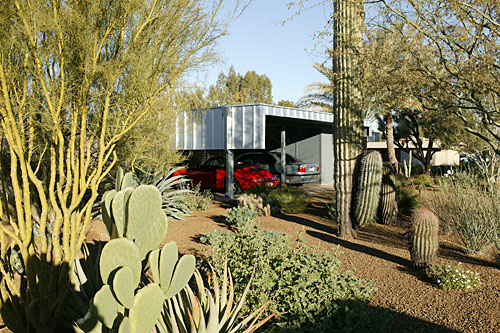
|
 Do you believe that you have to educate your customers or that you have to adjust to their views and vision for the project? How challenging is that? Do you believe that you have to educate your customers or that you have to adjust to their views and vision for the project? How challenging is that?
|
 There is a lot of education necessary on every project, interior and exterior. Much of the education deals with maintenance issues and details. There is a lot of education necessary on every project, interior and exterior. Much of the education deals with maintenance issues and details.
|
 Is there any open space in the Phoenix metropolitan area that you would like to re-design? Is there any open space in the Phoenix metropolitan area that you would like to re-design?
|
 I would love to see more architectural elements incorporated into our public parks and spaces. Even our freeways and college campuses. I applaud the Barry Goldwater Memorial Garden that was done with the vacant lot at Lincoln and Tatum. The Valley could be a more interesting place and have a more positive feeling if the negative energy of vacant lots was wiped away. The sites would stir conversation, interest and usability. I would love to see more architectural elements incorporated into our public parks and spaces. Even our freeways and college campuses. I applaud the Barry Goldwater Memorial Garden that was done with the vacant lot at Lincoln and Tatum. The Valley could be a more interesting place and have a more positive feeling if the negative energy of vacant lots was wiped away. The sites would stir conversation, interest and usability.
|
 What are some of your favorite materials to experiment with outdoors? What are some of your favorite materials to experiment with outdoors?
|
 Utah Ice, different stones and gravels, galvanized and perforated metals, aluminum hat channel, opaque Plexiglas, metal edging, sandblasted brick, block and glass, rebar and corrugated aluminum piping, stainless steel fire pits, retro patterned carpets and tile. Utah Ice, different stones and gravels, galvanized and perforated metals, aluminum hat channel, opaque Plexiglas, metal edging, sandblasted brick, block and glass, rebar and corrugated aluminum piping, stainless steel fire pits, retro patterned carpets and tile.
|
 What local resources do you like to use to find unique accents and materials for use in the garden? What local resources do you like to use to find unique accents and materials for use in the garden?
|
 Many of my sources are in L.A. and Palm Springs. The metal, block, etc. can be purchased here. Most of the furnishings come out of Palm Springs. Red Modern and DA Modern are great sources for vintage modern objects. Many of my sources are in L.A. and Palm Springs. The metal, block, etc. can be purchased here. Most of the furnishings come out of Palm Springs. Red Modern and DA Modern are great sources for vintage modern objects.
|
|
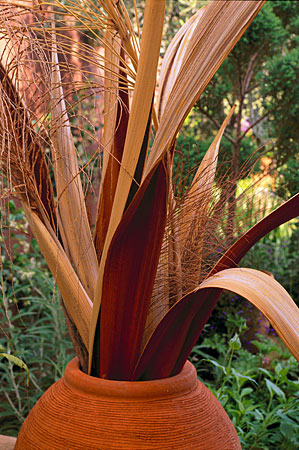
|
 What are some of the easiest ways to improve Modern curb appeal through sweat equity on a shoestring budget? What are some of the easiest ways to improve Modern curb appeal through sweat equity on a shoestring budget?
|
 I like either completely flat soil surfaces, like a tabletop or canvas, or extremely high berms of soil to make a wacky statement. Metal edging can be used to separate linear or angular patterns of multi-colored gravel while a fewer number of one variety of plant makes a clean, singular statement. An organic piece of sculpture surrounded simply with a circular pattern of grasses looks great floating in a sea of clean gravel. A great, sleek pot with an architecturally interesting specimen plant looks really swell. Try to avoid plant clichés. I like either completely flat soil surfaces, like a tabletop or canvas, or extremely high berms of soil to make a wacky statement. Metal edging can be used to separate linear or angular patterns of multi-colored gravel while a fewer number of one variety of plant makes a clean, singular statement. An organic piece of sculpture surrounded simply with a circular pattern of grasses looks great floating in a sea of clean gravel. A great, sleek pot with an architecturally interesting specimen plant looks really swell. Try to avoid plant clichés.
|
 Do you have any role models that you look to for inspiration? Do you have any role models that you look to for inspiration?
|
 To a certain degree Frank Lloyd Wright and Al Beadle have been major influences. Both seem to effortlessly integrate their projects into the site to create a feeling of oneness. Frank Lloyd Wright structures seem to rise out of the ground and soar, where Al Beadle's seem to connect, but hover. The angular clerestory windows of Ralph Haver and the Alexander-designed homes (in Palm Springs) allow for great natural light with minimal direct sunlight. The high windows also allow more of the vegetation to be seen from indoors, further connecting the interior/exterior experience. Neutra, E. Stewart Williams and William F. Cody are among other architects who have designed some incredible projects in Palm Springs (and other places). Blaine Drake is another Phoenix Architect I admire. There are numerous firms that are designing great architecture. But I'm an old, nostalgic soul who loves homes with histories and memories. To a certain degree Frank Lloyd Wright and Al Beadle have been major influences. Both seem to effortlessly integrate their projects into the site to create a feeling of oneness. Frank Lloyd Wright structures seem to rise out of the ground and soar, where Al Beadle's seem to connect, but hover. The angular clerestory windows of Ralph Haver and the Alexander-designed homes (in Palm Springs) allow for great natural light with minimal direct sunlight. The high windows also allow more of the vegetation to be seen from indoors, further connecting the interior/exterior experience. Neutra, E. Stewart Williams and William F. Cody are among other architects who have designed some incredible projects in Palm Springs (and other places). Blaine Drake is another Phoenix Architect I admire. There are numerous firms that are designing great architecture. But I'm an old, nostalgic soul who loves homes with histories and memories.
|
| |
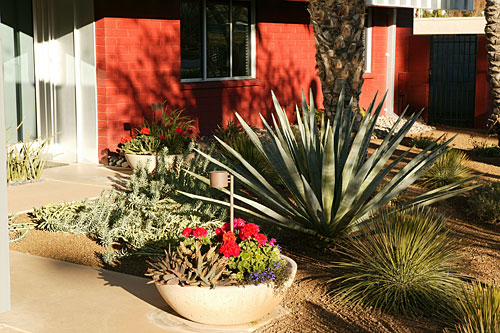 |
|  Who are some of the innovators in landscape architecture today? Who are some of the innovators in landscape architecture today?
|
 Of course I would like to think of myself as innovative. One minute I'm designing a mid-century modern garden in Paradise Valley and the next an Italian garden in Fountain Hills. Next week, a Japanese garden at the Phoenician. Of course I would like to think of myself as innovative. One minute I'm designing a mid-century modern garden in Paradise Valley and the next an Italian garden in Fountain Hills. Next week, a Japanese garden at the Phoenician.
Among others would be Steve Martino, Christy Ten Eyck and Kris Floor who I feel have made an impact in the Valley. They tend to be more desert plant purists... I enjoy working in greener environments like Central Phoenix, Tempe, Paradise Valley and Older Scottsdale. I feel more connected to my midwestern corn-fed roots of green grass and lush gardens. Don't get me wrong... I do enjoy the thrill of designing incredible native landscapes. It's thrilling to be working on so many different styles of gardens. It's less monotonous for all of us. |
|  How have your views on landscape architecture changed over the span of your career? Where do you think it is going? How have your views on landscape architecture changed over the span of your career? Where do you think it is going?
|
 I always admired modernist style and design. I was not an architecture aficionado until becoming the owner of an Al Beadle home in the Phoenix Mountain Preserve. It changed my life and career. It was then that I understood the importance of great, functional, architecture that feels right on the site and connects to the landscape. No one even knew I'd purchased a modernist 60's home but the phone was ringing off the hook for work on those kinds of projects. I definitely feel it's my niche and I am doing the work I am meant to. I want to save as much of the mid-century modern architecture as I can before it meets the wrecking ball of the fix-n-flip buyer. Owning a modern home with walls of glass has had a profound spiritual impact on my life. I can't see myself living in anything but mid-century modern surroundings. I always admired modernist style and design. I was not an architecture aficionado until becoming the owner of an Al Beadle home in the Phoenix Mountain Preserve. It changed my life and career. It was then that I understood the importance of great, functional, architecture that feels right on the site and connects to the landscape. No one even knew I'd purchased a modernist 60's home but the phone was ringing off the hook for work on those kinds of projects. I definitely feel it's my niche and I am doing the work I am meant to. I want to save as much of the mid-century modern architecture as I can before it meets the wrecking ball of the fix-n-flip buyer. Owning a modern home with walls of glass has had a profound spiritual impact on my life. I can't see myself living in anything but mid-century modern surroundings.
|
 The ModernPhoenix community is hungry for ideas that they can consume and transform into their own. Anything else you'd like to share? The ModernPhoenix community is hungry for ideas that they can consume and transform into their own. Anything else you'd like to share?
|
 It's important to seek out books, films and architectural tours. A trip or two to Palm Springs couldn't hurt! It's important to seek out books, films and architectural tours. A trip or two to Palm Springs couldn't hurt!
|








